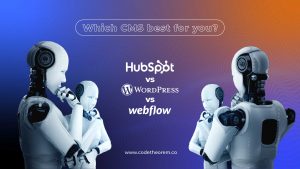Like every coin has two sides, the same applies to web development. There are two ends to web development; one is Front-end development and the other is Back-end development. As the name suggests, we use front-end languages for building the interface of your website and the application with which a user interacts. While the Backend languages are responsible for the website’s functioning along with tools like database, web servers, frameworks, and such.
The important thing here is choosing the right backend language for software development. A set of factors like reliability, learning curve, performance, and project requirements will influence your decision. Along with that, the demand of the hour will matter. You can’t opt for a backend language that is no longer in trend.
Article content
What is back-end development?
Front-end languages define how the application appears to the user whereas Backend languages keep the websites and apps functioning behind the scenes. Back-end deals with the server-side of the software development including data handling and the business logic. It is the combination of web applications, databases, and servers.
Back-end bridges the gap between the front end and the database. It is the server side of the website where all the operations take place. Every input or data you order is processed and displayed in front of you, thanks to the back end development.
The back end processes and completes the actions you see on screen. However, the users don’t access the backend. The codes written by the backend developer in the scripting backend languages help the front-end connect with the databases.
Top Backend Languages
1. Javascript
Javascript easily comes to our mind when talking about web development.
But did you know that Javascript is both a front-end and backend language? Used for web development JavaScript has an easy set-up for development and the community of JavaScript experts is the reason the majority of websites rely on it. JS is one of the most popular back-end programming languages. It is super scalable and the components of java are readily available.
The simple scripting syntax and the client-side validation features make it efficient for the back-end. Indeed, Javascript has richer interfaces along with lightweight scripting and interoperability makes it amazing. No doubt the popularity of Node.js has increased the use of JS as the backend language. Moreover, you get object-oriented programming support with JS.
Javascript has dynamic data types as the data types of variables are not predefined. Indicating you can reuse the variables. You can store any data type in the same variable. For instance, if you enter ABC in a variable you can later on store any other integer array in the same variable. Programmers use JS for client-side validation as it is fast and lightweight.
Moreover, one of its key features is async processing, if one of the scripts is running it won’t be able to stop or let the other block of the code wait for the response to function. When a request is processed the other will also work parallelly. Further, FB, Google, Netflix, and eBay use Javascript.
2. PHP – Hypertext Preprocessor
Designed specifically for web development, PHP is the acronym for hypertext preprocessor which means the code you write will be directly read by the computer and the compiler. It was launched in 1997. It is a backend language that has been entrenched in HTML. As the code is executed on the server-side making it a server-side backend language.
Some of the common uses of PHP are session tracking, administering databases and dynamic content, and designing eCommerce sites. Around 80% of the websites around the websites use PHP for the back end development. It has a built-in module to seamlessly connect with databases. Importantly, PHP allows smooth processing with multiple databases like MySQL, Oracle, SQLite, and more.
PHP is a part of the LAMP (Linux, MySQL, Apache HTTP, and PHP) stack – one of the most used technology stack. Also, you can easily deploy PHP backend apps to cloud services like AWS. All in all, the database flexibility and accessibility with PHP make it ideal for eCommerce sites, gaming apps, and social media. Some well-known users of PHP are WordPress, Yahoo, Mailchimp, and Wikipedia.
3. Node JS
Node JS is a JavaScript runtime environment. Around 1.3% of websites use NodeJS for server-side operations. Node JS backs the object-oriented programming paradigm which means it allows you to implement the apps using inheritance and classes. It is perfect for building web apps. There are many back-end frameworks in Node JS with each having its advantage and limitation. You can select them based on your requirements.
It runs the JS code on the server-side. Its reusability features reduce the code lines. Node JS is useful for IoT, single-page apps, and real-time chats. Further, the stream API allows web developers to build streaming apps.
Besides, the event-driven model offered by Node JS allows the developers to make changes to an app within a shorter time. Leading companies like Netflix, NASA, and LinkedIn use Node JS for their backend functions.
4. Python
Python is another one of the most popular Backend Languages ever. It helps simplify the process of development by providing a variety of libraries. In short, these libraries help shorten the development cycle time.
Moreover, the high-level security offered by Python i.e., the Open-source web application security project (OWASP) makes the apps you build less vulnerable. Also, it is simple compared to the other backend languages with its intuitive syntax, making coding easier and less inclined to errors and bugs.
The rich collection of libraries available is one of the reasons developers use python for game development and also for scientific and numerical applications. Additionally, coders prefer python for projects like IoT, AI, and ML as well. No doubt the biggest names like Spotify, Pinterest, Instagram, and Google rely on Python.
5. Rust
Welcome one of the newest and modern backend languages that are here to stay. Rust is a fast and memory-efficient programming language. Even though many see it as tough to learn, its security and fast speed even out things. Moreover, you can build anything you want with Rust.
All in all, it allows high performance along with processing a large amount of data, supports concurring programming, and is an effective compiler. These features are why many big companies like Firefox, DropBox, and Cloudflare use Rust.
6. GoLang
Call it Go or GoLang, Go was launched in 2009 by Google. GO is based on the syntax of the C languages. It is a masterful language that is easy to learn and relatively simple. Go offers high performance and supports multithreading.
Similar to Java, Go also supports concurrency, making it much better and lighter. And the feature called GoRoutines helps functions run simultaneously. Well, the backend developers can run millions of GoRoutines at a time. Go is a superb option for building highly scalable databases. Google, Basecamp, BBC, Uber, and Soundcloud use GoLang.
7. Ruby
We know the famous Ruby on rails framework created specifically for Ruby, a backend language. It allows backend developers to create and perform tasks as small as a single line of code instead of multiple lines. Ruby and Ruby on rails are quite simple making them the perfect option for beginners. They help speed up the process of creating a task or function for your software.
One of the exciting features of Ruby is Metaprogramming which allows the developers to create programs that will write the code autonomously. It provides flexibility and shortens the development cycle.
Also, RubyGems are libraries for web application features in Ruby. There are more than 160,000 RubyGems available. It helps developers solve a lot of problems through the RubyGems repository. Indeed, RubyGems are useful in solving eCommerce issues. Besides, Ruby is excellent for prototyping and for creating custom databases. Airbnb, Shopify, Github, and Basecamp use Ruby for their back end development.
8. Java
Being one of the popular backend languages, Java is used to build large high-security web apps. It is super scalable and the components of java are easily available. It is versatile and you can use it to build mobile, web, and desktop applications.
The Java Virtual machine JVM is responsible for the versatility and dependability of Java. It standardizes the code machine on which the programmers work instead of running the code on each machine programmers use.
Also, Java is preferable for beginners. Java is the ideal option for developing websites with the flexibility of platforms and consistency with JVM. Some of the java frameworks are Spring, Struts, and Grails. LinkedIn, Jenkins, Yahoo, NASA WorldWind, and much more use Java.
9. C#
C# or pronounced as C-sharp is an object-oriented backend language. It is one of the powerful backend technologies that you can use with frameworks like .NET for designing internal structures of webpages and for connecting client interactions to server interactions. Microsoft is the creator of C#. It was initially intended as a part of the .NET framework for developing windows applications. And now it serves for the backend web development.
Especially, for developing games in unity, C-sharp is the primary back end language. All of the libraries of Unity were built with C# codes. It runs across multi-platforms like Android, iOS, and Linux. No doubt it is one of the best website programming languages in development.
It is similar to C++ and C, both are backend languages. So if you’re new to C# but know the basics of C++ and C it will be easy to learn C#. Majorly, GoDaddy, Stack Overflow & visual Studio Unity Games uses C#.
10. Perl
Perl is short for Practical Extraction and Reporting Language. It is a multipurpose backend language that was originally designed for text manipulation, and it is now used for web development, network programming, GUI construction, and more. Perl is quite similar to C and will be easy for developers who know C and C++.
Perl is good at handling text errors and handling encrypted web data. When embedded into web servers it can help speed up the process by up to 2000%. Some commonly used frameworks are jiffy, Dancer, Catalyst, and Gantry.
Also, IMDB, Amazon & BBC are some of the popular names using Perl for back end development.
Conclusion
To conclude, the backend is like the backbone of a website or app. Without back end development, there’s no executing of actions with a pretty interface. Moreover, choosing one of the backend languages from above will certainly depend on the project requirements. Moreover, you will need to consider the learning curve as well.


















